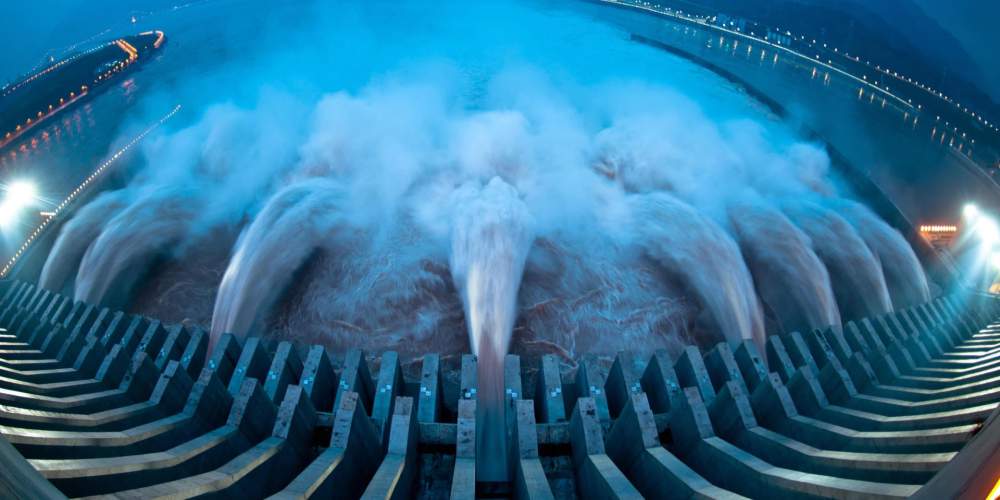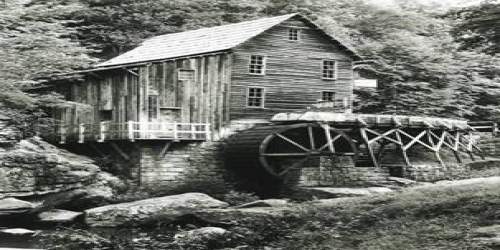Read Time : 6 Minutes
What are the Different Types of Hydroelectric Systems?
There are two main varieties of hydro turbine, though the technology used in both is much the same where the power of water is used to turn the blades of the turbine.
- Impulse turbines are not fully submerged but driven by falling water as in large scale power stations where the water comes from a reservoir via a channel onto the turbine.
- Reaction turbines, by contrast, are fully submerged in the water and as such are more suitable for low-head sites where the depth is over 20 metres.
Reaction turbines are a little more expensive and are physically larger constructions than impulse turbines, as more hardware is required to allow a reasonable flow rate to pass through. Outside of the large scale power stations that utilise huge reservoirs, there are two hydro systems, which are categorized depending on the water source used: run-of-the-river hydro and tidal hydro.
Run-of-the-river hydro
Run-of-the-river hydro systems don’t use a large reservoir to store water but have a continuous supply of moving water. An example of an industrial scale run-of-the-river hydroelectricity plant is the Chief Joseph Dam in Washington which does not have a sizeable reservoir. Run-of-the-river hydro can be divided into two categories according to scale: micro hydro, for homes and businesses, and larger hydro systems for commercial ventures or community projects.
COMPARE PRICES FROM LOCAL INSTALLERS
Compare prices from local companies fast & free
Enter your postcode to compare quotes from leading professionals. We promise to keep your information Safe & Secure. Privacy Policy
Micro Hydro
Though definitions of what size constitutes a micro hydro system vary, it often refers to those with outputs of less than 50 kW. These work in the manner outlined already, that is, by taking in water from a river and converting it into electricity but generally require less building work than larger systems.
- Home and business owners may find that micro hydro systems will comfortably produce all the electricity they require annually and perhaps a little bit more.
- Hydro systems are suitable for properties, business units and farms which are not connected to the national electricity grid.
- What’s more, if you are connected to the grid, the excess electricity you produce can be sold to your energy provider through the Smart Export Guarantee.
Micro Hydro systems typically produce under 50 kW and can be used to power single properties or small communities, depending on the size of the installation. The construction of a micro hydro system is normally pretty site specific and will depend on the type of landscape and other considerations. For example, you might have a ready-made dam area or pond that can be adapted or you may be next to free flowing river.
All micro hydro systems have the same basic construction, with a turbine leading to a generator that is then connected to the home, providing AC that can provide all electricity needs. There are a variety of turbine designs that create the mechanical energy to drive a generator, including:
- Reverse Archimedes Screw: Water going into the top of the device makes the screw rotate and this can be used to feed a generator. It is an ideal system to handle dirty water with variable flow rates and can operate at high efficiencies.
- Gorlov Helical Turbine: Helical blades or foils can create mechanical power independent of the water flow and have been used in tidal hydro systems.
- Kaplan Turbine: This is a propeller based system and provides efficient mechanical turn in low head situations and are the most widely used technology for energy production that uses turbines.
- Water Wheel: Harking back to the days when we used them for grinding wheat and corn, water wheels are still in use today, with the more advanced hydraulic wheel-part reaction turbine having efficiencies of over 80%.
- Gravitation Water Vortex: This is a simple design where the water from something like a weir or water fall is diverted into a basin that causes a vortex at the exit (much like water going down a plug hole) which drives a simple fan arrangement connected to a generator.
For the purposes of micro hydro, the types of turbine available can be split into two different types: impulse and reaction.
Impulse Turbines for Micro Hydro
These are more commonly used than reaction turbines because they are essentially simpler in design and therefore have less maintenance issues associated with them. All impulse turbines rely on the force of the water striking them and have two main types:
- Pelton Wheel: Water is pushed through a gradually narrowing pipe, increasing the pressure as it reaches the turbine. The wheel has cup shaped buckets that the water strikes and this causes it to move and turn the generator. It operates most efficiently at high head, low flow situations.
- Turgo Impulse Wheel: This is a slightly more efficient version of the Pelton Wheel and is angled so that the water hits more of the cup shaped buckets at the same time, creating a faster revolution.
For small amounts of electricity you can also get a Jack Rabbit turbine that can be dropped into shallow water and is capable of producing about 100 watts of power.
COMPARE PRICES FROM LOCAL INSTALLERS
Compare prices from local companies fast & free
Enter your postcode to compare quotes from leading professionals. We promise to keep your information Safe & Secure. Privacy Policy
Reaction Turbines for Micro Hydro
These are highly efficient but depend on the pressure created by the water rather than the speed with which it hits the turbine. In this respect, it is highly site specific and not suited to all projects. They are more complex in design which is why they are rarely used for micro hydro unless it is a specially designed project.
Off Grid vs On Grid The other difference between types of micro hydro system is whether they feed just one property that is off grid or connect to the grid and benefit from something like the Smart Export Guarantee (SEG).
Off grid is normally suitable for those properties that are in remote places and just need a power supply. Connecting to the grid is useful if you produce excess electricity as you can then earn extra money be selling that back to the energy companies which can give you a faster return on investment.
The cost of installing a micro hydro system is more expensive than some other renewable technologies and is also site-specific – in other words you need to be sure that the river or water area you choose is going to provide sufficient energy for your turbine. A small 1kW system that is off-grid can realistically set you back £10,000 depending largely on installation costs that will, in part, be determined by the location. A 5 kW turbine installed on a 25m head site and professionally installed may well cost the best part of £25,000.
Commercial and Community Hydroelectricity
Hydroelectric installations that have an output of greater than 50kW are suitable for commercial ventures and community projects. These often require more extensive civil engineering work and incur a greater cost, though they obviously produce more energy. Given that their impact on the surrounding area will be bigger, there are also more significant planning implications which need to be taken into consideration.
Hydroelectricity projects are becoming more popular for communities wanting to generate sustainable electricity and reduce their carbon footprint. A 100kW hydro system, for example, could provide enough energy to power 80-100 homes and, as with micro hydro systems, any surplus energy generated can be sold back to the energy companies under the Smart Export Guarantee (SEG).
This aspect of installing larger scale projects makes hydroelectricity a possible business investment opportunity for commercial concerns. The cost of a community hydro project can be as much as £750,000 as this scheme in Whalley, Lancashire demonstrates. Once the project is completed it is hoped that the 100 kW turbine will produce 345,000 kWh a year that will benefit from the Feed in Tariff and provide electricity for the local community.
Tidal Hydroelectricity
Tidal barrages have long been used to generate electricity, in much the same way as river-based hydro systems, by using fully submerged reaction turbines to exploit the difference in head between high and low tides. Tidal barrages are usually built across a bay or a river and have a significant impact upon the local ecosystem - this has even led some governments to refuse to approve their installation.
The technology is improving though. Newer tidal hydro systems function in a similar way to wind turbines. These are commonly referred to as tidal stream generators, tidal energy converters, or simply tidal turbines.
- Tidal stream generators feature propellers mounted on a mast which is submerged under water.
- Since the density of water is around 800 times greater than that of air, tidal turbines have the potential to generate significantly more electricity than wind turbines.
- Water speeds can be 10 times smaller than wind speeds but still produce a comparable amount of energy.
- Tidal turbines also have less aesthetic impact on the local environment and require less construction work than do tidal barrages.
Tidal energy is not currently an established way of generating electricity - there are only 7 tidal power stations in operation in the world, and only 2 in Europe. One is in the United Kingdom - a 1.2MW SeaGen tidal turbine at Strangford Lough in Northern Ireland. This turbine is funded 50% by the UK government and 50% by private investors and is licensed from 2008-2013.
What’s more, tidal hydro turbines are expensive, and there are only a certain number of suitable sites in the UK, which means that for communities and businesses tidal hydro is a less realistic option than river-based installations.
The good news is that large scale projects are beginning to be developed that could provide significant amounts of electricity for the National Grid. One of the big tidal projects beginning to get underway is the 250 MW installation in Swansea Bay from company Tidal Lagoon Power that could see electricity provided for up to 120,000 homes. The £650 million project could be finished as early as 2017 and be the first in a network of tidal hydroelectricity projects around the UK.
The Future of Hydroelectricity
The main factors that will affect the further development of hydroelectricity as a potentially major source of power in the future are twofold: The cost and the fact that locations are generally remote. A lot is currently being invested into the development of tidal technologies that means the sea around our shores could well be more important in the future than we currently think.
Is Micro Hydro Right for your Property?
There’s no doubt that a renewable energy source such as micro hydro can produce quite large benefits for a property. The problem lies in the planning and construction stages and choosing the right system for your needs. In truth most homes do not have access to the right resources to undertake a project of this kind, but if you do then the factors you need to consider are the flow and the head.
- Flow is the speed of water passing, which is how much is going by each second. People often distinguish between low flow and high flow.
- Head is the difference in height over a reasonable difference.
It is also important to think about what happens to the river over a year. Does the water flow slow considerably? Often the minimum flow in drought conditions is the deciding factor as to whether your site is suitable for a micro hydro system. Find out more about the suitability of your property for micro hydro.
Installers of Micro Hydro
Hydroelectricity on a smaller scale is a growing industry and there are a number of manufacturers and installers available who can advise on the right kind of system for your property. Find out more about installers of micro hydro here.
Find a local installer
Welcome to the biggest directory of UK renewable energy companies





 Is Hydroelectricity Generation Worth it
Is Hydroelectricity Generation Worth it


